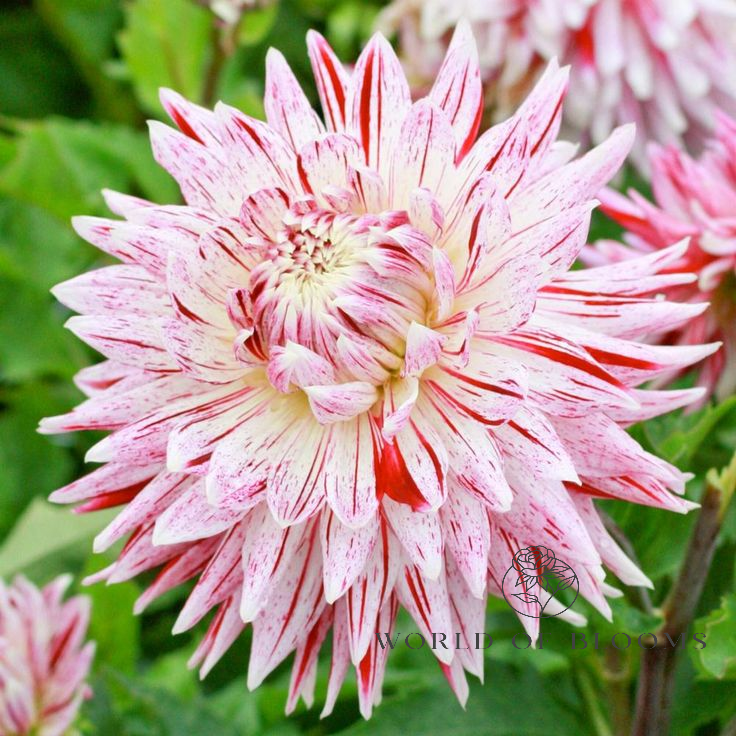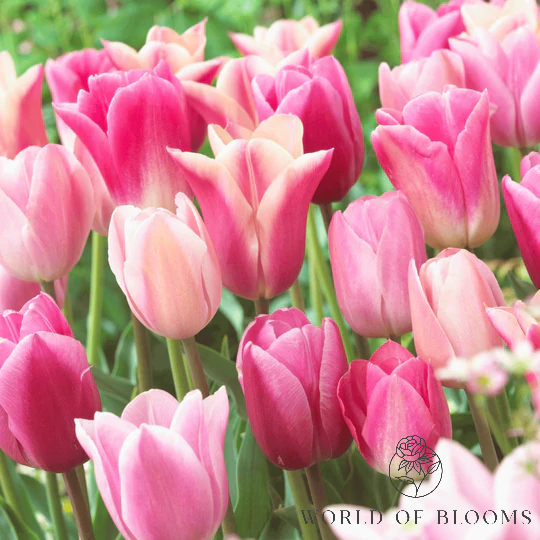Dahlia Dinnerplate 'Avignon'
Couldn't load pickup availability
Dahlia Dinnerplate 'Avignon' is an exceptional variety known for its large, vibrant, and multi-tonal blooms. The combination of bold pink and fuchsia hues, along with its giant flower size, makes this variety a standout in any garden. Whether used in landscaping, garden beds, or as a cut flower, 'Avignon' is sure to captivate and impress. With proper care, including adequate sunlight, well-drained soil, and some support for the large flowers, this dahlia will thrive and provide a stunning visual display throughout the growing season.
Zones: 3 - 11
General Characteristics:
- Type: Dinnerplate Dahlia
- Flower Shape: The flowers of Dahlia 'Avignon' are large, round, and exhibit the typical dinnerplate form. This means the blooms are exceptionally large, with multiple layers of broad, flat petals that give the flowers a rounded, almost flat look. The petals radiate out symmetrically, creating a beautiful, full display.
- Bloom Color: The flowers of 'Avignon' are a vibrant blend of rich, deep pink and fuchsia hues. The petals are often a strong pink with darker, almost magenta edges, creating a dramatic contrast and a multicolored effect. The central part of the flower is usually lighter in color, with a softer pink tone.
- Flower Size: The blooms are extremely large, often reaching a diameter of 8 to 10 inches (20 to 25 cm), which is characteristic of the Dinnerplate category. These blooms are some of the largest you can find in dahlias, making them highly attractive in gardens and floral arrangements.
- Petal Texture: The petals are smooth and firm with a slightly waxy texture, which helps them maintain their shape even in humid or rainy conditions. The petals are wide, with a slightly ruffled appearance along the edges, contributing to the full, fluffy look of the flower.
Plant Characteristics:
- Height: Dahlia 'Avignon' is a tall variety, typically growing between 3 to 4 feet (90 to 120 cm). Its height makes it a striking addition to garden beds and borders.
- Spread: The plant has a moderate spread, reaching about 18 to 24 inches (45 to 60 cm) in width. This allows it to fill out a space without becoming overly sprawling.
- Foliage: The leaves are large, deep green, and have a glossy appearance. The foliage is robust and provides a good backdrop for the large, colorful flowers. The leaves help to contrast the bold colors of the blooms.
- Growth Habit: 'Avignon' has an upright growth habit, with strong, sturdy stems that can support the large, heavy blooms. However, because of the size of the flowers, the stems may need staking or support to prevent them from bending or breaking, particularly in windy or rainy conditions.
Growing Conditions:
- Sunlight: Like most dahlias, 'Avignon' thrives in full sun, requiring at least 6 hours of direct sunlight per day for optimal growth and bloom production. Sunlight is essential to encourage healthy flower development and vibrant colors.
- Soil: The plant prefers well-draining, fertile soil that is rich in organic matter. Slightly acidic to neutral soil (pH 6.0 to 6.5) is ideal. Amending the soil with compost or well-rotted manure will improve its structure and nutrient content.
- Watering: Consistent moisture is important, especially during the growing season. The soil should be kept moist but well-drained, as dahlias do not like to sit in waterlogged soil. Overwatering or poor drainage can lead to root rot.
- Hardiness Zone: 'Avignon' is suitable for USDA hardiness zones 8 to 10. In cooler climates, it can be grown as an annual, or the tubers can be dug up and stored indoors during the winter months and replanted in the spring.
Blooming Period:
- Flowering Time: Dahlia 'Avignon' begins blooming in mid to late summer, usually starting in July. It continues to bloom until the first frost in the fall, providing a long-lasting display of large, colorful flowers for several months.
- Pollinators: The large, showy flowers attract various pollinators, including bees, butterflies, and hummingbirds. These insects are beneficial for the garden, promoting pollination of other plants as well.
Care and Maintenance:
- Deadheading: Regular deadheading, or the removal of spent flowers, is important to encourage the production of new blooms and to keep the plant looking tidy.
- Fertilization: A balanced fertilizer can be applied in early spring to promote healthy growth. Once the plant begins to bloom, a fertilizer higher in phosphorus and potassium will support the production of large flowers. Avoid high-nitrogen fertilizers, as these can promote leaf growth at the expense of blooms.
- Pest and Disease Control: While generally resistant to pests, dahlias can sometimes attract aphids, slugs, and snails. Keeping the plant well-maintained and free from debris can help prevent pests. Additionally, ensure that there is good air circulation around the plant to reduce the risk of fungal diseases like powdery mildew.
- Staking: Given the size of the blooms and the height of the plant, staking is often necessary. Providing support helps prevent the heavy flowers from toppling over or bending the stems.
Uses:
- Garden Beds: 'Avignon' is an excellent choice for large garden beds or as a focal point in flower borders. Its impressive size and color make it stand out in any garden setting.
- Cut Flowers: Due to its large, vibrant blooms and long vase life, 'Avignon' is a popular variety for floral arrangements. The flowers last well in a vase, often staying fresh for up to a week or longer. This makes it a favorite among florists and home gardeners.
- Landscaping: The bold, dramatic blooms are perfect for adding a splash of color to landscaping designs. Whether used in mass plantings or as a specimen plant, 'Avignon' provides a striking visual impact.
Planting Instructions
1. Choosing the Right Location
Dahlias require specific growing conditions to thrive, so selecting the right spot is key:
- Sunlight: Dahlias love full sun. Choose a location that receives at least 6-8 hours of direct sunlight each day. The more sun they get, the better the blooming.
- Soil: Well-drained, fertile soil is essential. Dahlias do best in slightly acidic to neutral soil (pH 6.0 to 7.0). If your soil is heavy clay or drains poorly, amend it with organic matter (like compost) to improve drainage and fertility.
- Protection from Wind: Although dahlias are relatively tall and sturdy, they can be vulnerable to strong winds. Plant them in a sheltered spot to prevent breakage or damage to the flowers.
2. When to Plant Dahlias
Dahlias are warm-season flowers and should be planted once the threat of frost has passed and the soil has warmed up. In most regions, this means planting them in late spring, typically around late April to early May, after the last frost date.
- Soil Temperature: The ideal soil temperature for planting dahlia tubers is around 60°F (15°C). If the soil is too cold, the tubers may rot before they have a chance to sprout.
3. Preparing the Soil
Good soil preparation helps dahlias grow strong and healthy:
- Amend the Soil: Before planting, work compost or well-rotted manure into the soil. This adds nutrients and helps with drainage.
- Loosen the Soil: Dahlias have tubers that need to spread out, so make sure the soil is loose, not compacted.
- Add Fertilizer: Mix a slow-release balanced fertilizer or one specifically designed for flowering plants into the soil before planting to give your dahlias a nutrient boost.
4. Planting the Tubers
Once the soil is prepared, it's time to plant your dahlia tubers.
- Spacing: Dahlias should be spaced about 18-24 inches (45-60 cm) apart, depending on the variety. Taller varieties may need more space, while compact varieties can be planted a bit closer together.
- Planting Depth: Dig a hole or trench around 6 inches (15 cm) deep. Place the tuber in the hole with the "eyes" (small, bud-like protrusions) facing upward. If you’re planting multiple tubers, make sure there is enough room for the tubers to spread out as they grow.
- Orientation: If the tuber has a noticeable direction (like a flat side), plant it so that the eyes are facing upward. If unsure, it’s fine to plant the tuber sideways or with the flat side facing down.
- Covering: Gently cover the tuber with soil, and water it well after planting. Avoid burying the tuber too deeply; about 6 inches is ideal. The soil should be loose enough to allow the tuber to sprout easily.
5. Watering and Mulching
- Watering: After planting, water the area thoroughly to settle the soil around the tuber. Keep the soil evenly moist, but not soggy, while the tubers are establishing themselves. Once the plants start growing, they need consistent moisture, especially during dry spells.
- Mulching: Apply a thin layer of mulch around the plants to help retain moisture and suppress weeds. Organic mulch like straw, leaves, or grass clippings works well. However, avoid placing mulch directly on the tubers.
6. Staking or Supporting Dahlias
Dahlias can grow tall, especially larger varieties, so they may need support:
- Staking: To prevent the stems from flopping over, you can insert stakes near the plants and tie the stems loosely to the stakes. This is especially important for tall varieties or those with large flowers.
- Cages: Another option is to use a wire cage around the plant to provide support as it grows. This keeps the plant upright and the flowers undamaged by wind or rain.
7. Fertilizing and Care During the Growing Season
Once your dahlias are planted, it’s important to feed and care for them as they grow:
- Fertilizing: After planting, you can give dahlias a light dose of a high-phosphorus fertilizer to encourage blooming. Later in the growing season, switch to a balanced fertilizer or one that is lower in nitrogen. Over-fertilizing with too much nitrogen can result in lush foliage but fewer flowers.
- Deadheading: Remove spent blooms regularly to encourage new flowers and keep the plant looking tidy.
- Pruning: Prune the stems lightly to encourage branching. If you're growing large varieties, you may want to pinch off the top few buds to encourage bushier growth.
8. Aftercare and Harvesting
- Watering: Ensure that dahlias receive regular watering throughout the growing season, especially when the weather is hot and dry. The soil should stay moist but not waterlogged.
- Cutting Flowers: Dahlias are wonderful cut flowers! If you want to enjoy them indoors, cut them in the early morning or evening when they’re freshest, and place them in water immediately.
9. Overwintering Dahlias (for cold climates)
- Digging Up Tubers: In colder climates (zones 7 and below), you’ll need to dig up dahlia tubers before the first frost hits. Carefully lift the tubers with a spade or fork, being careful not to damage them. Trim the foliage and let the tubers dry for a couple of days in a cool, dry place.
- Storage: After drying, store the tubers in a cool, frost-free location, like a basement or garage, in a box with peat moss, sawdust, or sand to keep them dry. Check on the tubers periodically to make sure they haven’t rotted.



Recently viewed







